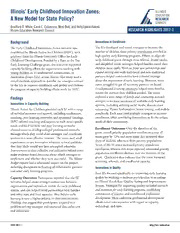
ERIC ED574339: Illinois' Early Childhood Innovation Zones: A New Model for State Policy? IERC 2017-1. Research Highlights PDF
Preview ERIC ED574339: Illinois' Early Childhood Innovation Zones: A New Model for State Policy? IERC 2017-1. Research Highlights
Illinois’ Early Childhood Innovation Zones: A New Model for State Policy? Bradford R. White, Carol E. Colaninno, Mimi Doll, and Holly Lewandowski Illinois Education Research Council RESEARCH HIGHLIGHTS 2017-1 Background Innovations in Enrollment The Early Childhood Innovation Zones initiative was The IZs developed and tested strategies to increase the established by Illinois Action for Children (IAFC), with number of children from priority populations enrolled in guidance from the Illinois Governor’s Office for Early high quality early learning programs. Efforts to align the Childhood Development. Funded by a Race to the Top- early childhood system through cross-referral, shared intake, Early Learning Challenge grant, this initiative supported and simplified intake strategies helped families enroll their capacity building efforts for organizations working with children more easily. Work to foster new partnerships and young children in 11 underserved communities, or expand existing ones with traditional and non-traditional Innovation Zones (IZs), across Illinois. This study used a partners helped communities form a shared message mixed methods approach to describe the strategies utilized about the importance of early learning. However, some by the IZs to improve enrollment and quality and evaluate zones struggled to get all necessary partners on board. the progress of capacity building efforts made by IAFC. Developmental screening campaigns helped more families receive the services their children needed. The zones Findings explored a wide range of family and community outreach strategies to increase awareness of available early learning Innovations in Capacity-Building options, including utilizing social media, door-to-door Illinois Action for Children provided each IZ with a range canvassing, Parent Ambassadors, home visiting, and mobile of technical assistance and supports, including conferences, preschools. Each zone used multiple strategies to increase coaching, peer learning networks, and sponsored trainings. enrollment, often combining innovations to fit the unique IAFC tailored coaching and support to each zone’s specific needs of their community. needs and local context, and peer learning networks Enrollment Outcomes: Over the duration of the allowed zones to develop collegial professional networks grant, overall priority population enrollment across all through which they could share strategies and coordinate zones grew by 12% and most zones also increased their services in a more effective manner. The zones used small share of students who were from priority populations. experiments to test innovative solutions to local problems Seven of the 11 zones increased priority population that they likely would not have attempted otherwise. enrollment, whereas two zones reported substantial priority Improvements to data collection and utilization helped zones population enrollment declines over the duration of the make evidence-based decisions about which strategies to grant. Qualitative data indicate that the zones increased implement and whether they were successful. The Illinois screening, referrals, and enrollment capacity. budget impasse had a substantial impact on the project, including disruptions to funding of collaborative partners Innovations in Quality and other early learning programs. Four IZs focused specifically on improving early learning Capacity Outcomes: Participants reported that the IZ quality by working to increase participation in or ratings initiative helped create stronger connections between on Illinois’ ExceleRate Quality Rating and Improvement organizations and individuals within the early childhood System. Strategies for improving quality included outreach system, and also helped build partnerships with families and incentives for early learning programs, establishing and other state and local agencies. They believe early communities of practice, and coordinated professional learning is now a higher priority in their communities. development. More ambitious professional development Findings also suggest that participants acquired new efforts taxed zone resources with regard to capacity, problem-solving strategies and improved data collection technology, and time. and utilization. IERC 2017-1 http://ierc.education Quality Outcomes: Quantitative data indicated that Conclusions ExceleRate quality ratings increased across all zones and The IZ project was successful in building capacity and within each zone over time. At the beginning of the grant, helped 11 high need communities move to new, more 34% of participating centers were rated Gold and none collaborative mindsets. The IZ project represented a had earned an Award of Excellence. By the end of the bold experiment for early childhood education systems grant, 40% were rated Gold and 4% earned an Award of and policy in Illinois—a state-level capacity-building Excellence. policy process that defers to local expertise for creating local solutions to local problems using local resources. Policy Implications This approach avoids some common pitfalls of state-level Implementation: The IZ model requires policy that is programs, but there are inherent trade-offs, especially given flexible enough to account for variations in local capacity, that it is relatively untested. while also being sufficiently well-defined to achieve intended outcomes. However, as would be expected with such a new approach, project leadership occasionally struggled to properly calibrate the supports delivered to each zone. Moving forward, policymakers should consider how to ensure that such policies build on state capacity and existing research on best practices, while also being sensitive to local context. Human Capital: Given the close link between early learning outcomes and access to high quality programs, human capital concerns must be addressed as part of a comprehensive approach to improvement. However, because staff compensations comprises the bulk of early learning budgets, policymakers must seek innovative solutions to improve teacher qualification while still keeping early learning programs affordable for families. Data: The IZ theory of action depended on systemic thinking driven by data. Unfortunately, the lack of uniform and systematic collection of early learning data hindered this approach to some extent. As communities begin to coalesce around a common agenda, the ability to share quality data becomes critical, and this will become even more important as community change strategies shift to a multi-sector, coordinated approach. The full report is available at http://ierc.education For further information, contact the IERC at Southern Illinois University Edwardsville IERC 2017-1 http://ierc.education toll-free at 1-866-799-IERC (4372) or by email at [email protected].
